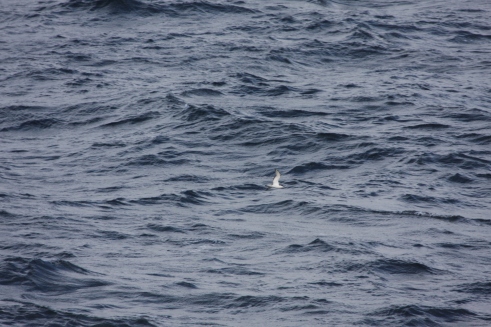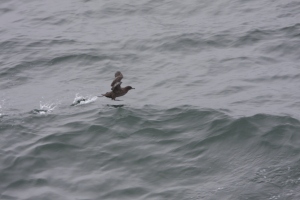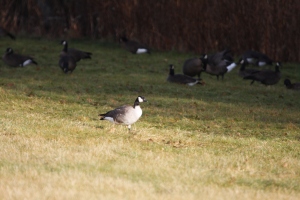
Buller's Shearwater Hecate Strait, fall 2010; one (not this one) seen on CBC 2009 Photo: M. Hearne
We’ve just completed six CBC’s for Haida Gwaii, Rose Spit, Hecate Strait, Greater Massett, Port Clements, Skidegate Inlet and Tlell. The counts are always challenging. It’s mid-winter and the weather is always variable and downright chilly. Trying to complete and compile six takes a while. We have been doing CBC’s here now for thirty years! Hard to believe, but we’ve learned an immense amount about how important Haida Gwaii, The Queen Charlotte Islands, off the west coast of Canada is to migratory and wintering birds.
Hecate Strait is the main migratory route for all birds on the Pacific Flyway, from Brant to Barn Swallows, shearwaters to shorebirds. If a windfarm was ever built there, as had been proposed, it would be devastating to all migratory birds on the Pacific Flyway.
This year we had nothing incredibly rare, like the Little Bunting found two Christmases ago, but CBC’s generate such a lot of activity and there are so many people on the lookout for birds that something unusual always turns up. We’ve compiled reports below. Welcome to our web story.
Rose Spit

Rose Spit in the rough. Photo: M. Hearne
Short-tailed Shearwaters were the birds of the day. Up to seven soared in the wild seas just offshore and over 500 Sanderlings ran along the beaches in the pouring rain. We didn’t know when we’d do it so there wasn’t a lot of advance planning, but with concerts and counts and cards and Christmas, it seemed that the sooner this count was completed, the better. It’s such a risky place to get to in winter and it has its own weather. The morning was perfectly calm and dry with a stunning red sunrise. What could go wrong? The weather. While we stood counting loons near the end of the spit, we noticed a long dark cloud approaching from the south and within fifteen minutes it was over us. Bam! Stinging rain and high winds hit us and stayed with us for the rest of the day. The hundreds of loons speeding around the spit when we first got there had a message, we should have followed them back to Tow Hill. But we toughed it out. Ancient Murrelets landed close by and Short-tailed Shearwaters soared beside us. A tiny Song Sparrow came out from among the logs and a few Red-necked Grebes dove close by. But we had to leave, it was just too exposed. We went south down East Beach. It has changed a lot since we were last there. There are larger ponds, shifting sandbars and buried logs. Along the inside path where we often found sparrows, a dense spruce plantation has sprung up. We found chickadees, kinglets and a few song sparrows, but nothing new. On the way home the gull numbers along Tow Hill beach were incredible. Mew, Glaucous-winged, Western, Thayer’s, Herring and California fed along the waterline for miles. Eagles dropped in from time to time and a Peregrine Falcon swept low over the fringe of trees bordering the beach. Over 500 tiny white Sanderlings ran among the gulls and three very rare Glaucous Gullswere mixed in with the lot. There were more, but we got so wet we were beginning to get hypothermic. It was time to go home; to the wood stove, hot tea and cookies. Enough with the birds!

Sooty Shearwater in Hecate Strait Photo: M. Hearne
Hecate Strait
Yellow-billed Loons, including one that landed right beside the Northern Expedition as we waited to depart from Skidegate were the birds of the day. Offshore a number of Thick-billed Murres showed up and high numbers of Common Murres swam and dove beside the ship. Birding conditions were excellent; the sea was rippled with a light-southeasterly swell and it stayed dry all day. We had caught a ‘weather window’; the previous day was wet and windy and the next day was so stormy that the ferry was delayed for 24 hours. Our return journey was equally calm, although the ferry left at 2.30 pm, so there wasn’t much light left for birding. We had hoped for an exotic or two after the hurricane force winds the previous two days, but no such luck.
There may be a ghost bird living on the ship. While Margo was warming up over a cup of hot tea in the cafe, friends came to say that they had seen “something circling around the ship and it may have landed, it seemed to be whitish, with a small head, and was either carrying something in it’s feet or had feathery feet.” I called Peter on our ‘talkabouts’ and he and a member of the crew checked the decks. Small feathers with black edging drifted among the chairs on the back deck but that was all. Then, on our return journey, the crew member told us that he had found a piece of wing and leg of a small bird. The rest had been eaten. The Northern Expedition is a big ship, has a Peregrine Falcon or other raptor taken up residence on the high deck? Falcons are particularly partial to Ancient Murrelets and we saw quite a few on the day of the count.
Greater Massett
Canada Geese, those faithful and long-lived birds, are a testament to healthy living. Up early, on the move and into the meadow for breakfast. They were the second birds of the day, Martin’s Saw-whet Owl calling from the dark forest was the first; then a bold Raven yelled the morning in so off we went. While Martin beat the bushes rousing creepers, kinglets and chickadees, Robert spotted three small sparrows in Old Massett and told us where they were. We got a photo in the rain. Two White-crowned and one Golden-crowned Sparrow. They hadn’t been seen all winter, and there they were. Jack also had one, even though the day before all the birds at his feeder had left. Marg was convinced the Collared Doves would be around on count day, but they weren’t. They were there the day before and the day after. Belted Kingfishers, usually sure things, didn’t show up either, but turned up next day at the Seaplane Spit where they always hangs out. The ways of birds are mischievous. If we didn’t know better, we’d swear they had a sense of humour. Maybe we don’t know better.
“Dang the weather”, we muttered in the afternoon when the rain started. “Not another rainy afternoon. We don’t want to walk down Cemetery Road, or tramp the golf course, or walk the beach. There’ll be nothing there.” Wrong. There was an incredibly unusual Redpoll feeding all by itself on the gravel like a mere windblown leaf. Pine Grosbeaks, absent for a few days, turned up just by my right shoulder. Did Peter know that among the hundreds of diving duck at the sewage lagoon a Ring-necked Duck would show up? And the little Brown Creeper, as elusive as a mouse in a hayfield, ran up a big tree just in front of Martin. The morning was bright as a lark, the Hairy Woodpecker called loudly from a lone tree at Entry Point, Peter found the Western Gulls where they should have been anyway and next day, just to keep up to the list, Martin saw six Trumpeter Swans flying along the ridge, a kingfisher sat on the wire where it always sits, and six White-fronted Geese at the golf course clattered off when our bad dog chased them. We never ever know what birds are going to show, but before I go I must quote from a new book received for Christmas. “If herds of buffalo or caribou moved through, I’d no doubt go out and see them…but…the only remaining wild animals in abundance that carry on in spite of human development are birds.” (Rosen:The Life of the Skies) Yep. In spite of all the damage we do, they are still here, 80 different bird species, in mid-winter, when most of northern Canada is flattened by snow.

Common Redpoll; Delkatla Wildlife Sanctuary; Dec 27 2011. Margo's photo in the rain
Port Clements
It’s a wonderful place for birding. The Yakoun and Kumdis Rivers drain into Masset Inlet so waterfowl are usually present. A Eurasian Wigeon fed with wigeon, pintail, teal and Mallard and small flocks of Dunlin sped around. The lonely cry of a seagull rang out over the quiet town in the early morning. Grey skies have been sitting over us all for weeks and most birds don’t like venturing out too far if they’re going to get soaked. Not so humans, especially during the Christmas Bird Counts. We got soaked. Again. But it was nice weather for ducks. At Kumdis Slough they were all lined up ready to be counted. Pintail, teal, wigeon, mallard. One Eurasian Wigeon and a Red-throated Loon, not always seen on this count. A congregation of shorebirds, like tiny nuns, heads down against the rain, sat at the end of a gravel spit around the corner from the flock of eight Canada Geese who took off in startled disarray when Margo showed up. She was equally startled but couldn’t fly. The nineteen Trumpeter Swans at the Yakoun Estuary, were down from the forty-seven seen earlier. The downpour eased off a little at Juskatla and allowed us to see seven Hooded Mergansers, four Ring-necked Ducks, four more Trumpeter Swans and twelve Gadwall swimming peacefully with a bunch of geese. Two Killdeer, the only ones for the day, chirped on the gravel beach. We drove a bit further inland than usual hoping for something different and, sure enough, fifteen Barrow’s Goldeneye showed up. On the way back to town eleven flickers flicked from the sides of the road. Our collective notebooks said ‘rain all day’ so we called it a day at 3.30 pm when we couldn’t see a thing.
Skidegate Inlet
After the blasting we got at Rose Spit this count was balmy. The wind was down, the intermittent sun was pleasant and the waters were as calm as glass. Over 300 Western Grebes swam away from the Kwuna ferry and Common Murres dotted the sea. The boat crew had a great day on the water, seeing many Marbled Murrelets and diving ducks, including grebes and scoters. The tide was out at Sandspit, so the few shorebirds visible were on the pilings under the Government dock. Black Turnstones and Rock Sandpipers sat in the shelter as Common Goldeneye dove and swam nearby. Two Savannah Sparrows appeared and one American Pipit called overhead. The five Snow Geese that have been around for a while are still there along with twelve Aleutian Canada Geese, and, where last year Varied Thrushes fed in huge numbers along the highway, this year many Northern Flickers fed in the meadows and under the trees. The storm from a few days earlier had dropped tasty things on the ground so they took advantage. All three species of woodpecker were found in the forest and a Brown Creeper called from the trees in the early morning. Black Oystercatcher numbers were down a bit but are still around and a Eurasian Wigeon fed with the American Wigeons in the bay. Eurasian Collared Dove are wintering here for the first time, even though they’ve been seen now for four years. They are small doves with a black strip at the back of the neck; they come to feeders and sit the power lines. We don’t always get Redpolls, when we do they’re usually in flocks, but this year there was one. Martin found it feeding in an alder bush, saw it being chased off by a Sharp-shinned Hawk and watched it return, clearly hungry, as it continued to feed busily on alder seeds while we watched. It, with the Golden-crowned Sparrow, added a nice touch to the day. The last birds for the day were a Merlin over the trees and a Thick-billed Murre in the water.
Tlell
Another bright morning. Shorebirds swept by, turned and landed along the shoreline at Misty Meadows, three Brown Creepers called and Cacilia’s dog romped with ours after a 50-second standoff. They had a great time. We did well too, with gracious cups of coffee, smoked salmon, apple pie and bread fresh out of the oven. Delicious. It was especially good after we’d stood for hours shivering in the chilly day counting thousands of birds in the offing or walking miles through the forest looking for a nuthatch or sapsucker. Both were elusive, but Martin got a Red-tailed and Sharp-shinned Hawk on his travels while Peter and I counted diving ducks swimming and feeding as far as the eye could see. If we didn’t have a spotting scope we’d have thought that there was nothing out there, just a dead zone, but after three hours of counting, tell that to the fairies. Red-throated, Common and Pacific Loons, Horned, Western and Red-necked Grebes, three species of scoter, a few Harlequin Ducks, many Common and Red-breasted Mergansers, a few Bufflehead, and literally thousands and thousands of Common Goldeneye. It’s time we changed the names of birds. Common Loons are not common, nor are the mergansers or goldeneyes. They may have been common when they were named a hundred years or so ago, but it’s time for a change. In the meadow and river Noel found many dabbling ducks, geese and Trumpeter Swans plus some juncos and Varied Thrushes to top up the count. It was a great day until about 3 pm when the tide turned, the wind came up and the weather went to the bad. So we finished up around 3.30 pm.
We are just now just beginning to compile the counts and get them ready for input, so the final totals will be available in the next few weeks.





